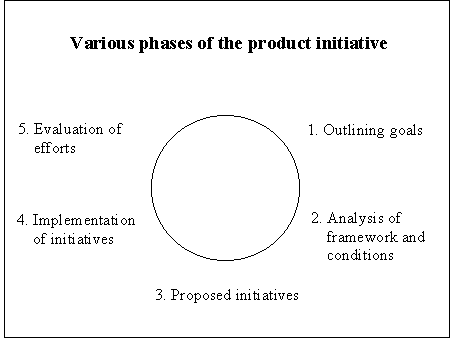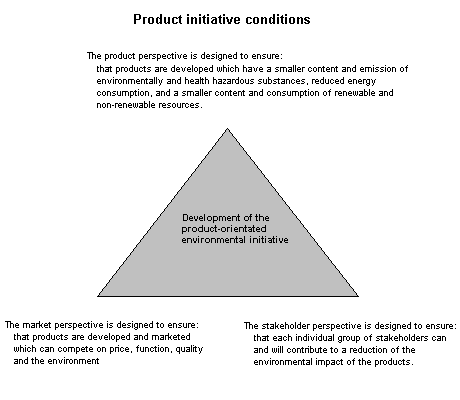|
[Front page] [Contents] [Previous] [Next] |
Intensified Product-orientated Environmental Initiative
3 Product-orientated environmental initiative - the process and goals
3.1 Introduction3.2 Product initiatives as a process and a dialogue
3.3 Overall goals for product initiative
3.1 Introduction
Chapter structureThis chapter describes the Danish EPA's proposal for a process to sharpen the focus on the product-orientated approach to environmental problems - including possible short-term expectations from intensified product initiatives.
This proposal is basically structured along the same lines as the proposal for the continuing process. This correlation is also described below.
Overall objectives
The proposal for intensifying the product-orientated environmental initiative takes
as its starting point the challenges outlined in the preceding chapter, as well
as a series of proposals for overall objectives. The overall objective
proposals are described at the end of the chapter.
3.2 Product initiatives as a process and a dialogue
The idea is to supplement the source, medium and chemical-orientated approaches to environmental efforts with a fourth and more general product approach. This suggestion for intensifying product efforts is a proposal for an incipient all-round initiative.Setting the process in motion
The concrete initiatives, which will be suggested, are far from being sufficient to
achieve the overall environmental goals. First and foremost, the ambition is to
set in motion a process capable of inciting stakeholders to start changing
their course.
The results of such efforts will depend on changes in many areas involving many stakeholders. It must therefore be expected to take years before the results manifest themselves in the form of established markets for less environmentally degrading products.
On the basis of i.a. the experience gained from the introduction of organic foods, it is judged that the proposed efforts will contribute to establishing new markets for less environmentally degrading products within a number of product groups within a period of approximately five years.
First results within a couple of years
The first results of the initiative, however, are expected to be recordable within
just a couple of years, behavioural modifications becoming visible among a
number of essential stakeholders in the form of increased production, supply
and marketing of a number of less environmentally degrading products. This will
reduce the environmental impact and resource consumption but any change to the
state of the environment will not likely be recordable.
Proposal for a dialogue
The product initiative is a process based on acknowledging the usefulness and
necessity of very actively involving the stakeholders concerned in developing
the initiative. Both goals and analyses as well as proposals for specific
initiatives should be discussed and adapted in the ongoing work. The dialogue
and process involved in developing more environmentally sound products are not
just means of achieving the product-orientated environmental initiative - to a great extent, the dialogue is the product-orientated environmental initiative.
The proposed process is cyclical, passing through the same phases at regular intervals and starting each new phase from the results currently achieved.
A repetitive process in five phases
As suggested in the drawing below, the product-orientated environmental initiative
is operated in five phases: outlining of goals, analysis of framework and
conditions, concrete proposals for initiatives, implementation and evaluation.
 Figure 3.1
Figure 3.1
The various phases of the product initiative
Phase 1
1. Outlining of goals. First, both environmental and other goals should be laid down for the product initiative.
In Section 3.3, a series of overall goals are proposed.
Phase 2
2. Analysis of framework and conditions. A product-orientated environmental initiative must, of necessity, be based on the complex interaction between products, stakeholders and market. It is therefore central to analyse the framework and conditions for the product initiative on the specific basis of the products, the market and the stakeholders. These
three points of view are evaluated together in order to cover an essential part
of the general conditions for the initiative.
Chapter 4 analyses the conditions and framework for products. The product perspective
is intended to shed light on the products at which the product initiative is targeted. What environmental properties and other aspects of the individual product should be improved? What are the possibilities of enhancing the environmental properties of the products?.

Figure 3.2
The triangle of conditions
Chapter 5 analyses the conditions and framework for the market. The market perspective is intended to shed light on the conditions governing the production and marketing of less environmentally degrading products on the national and international market. What are the possibilities of influencing those conditions, taking into account the competitive situation of the Danish companies, and the agreements that Denmark has entered into?
Chapter 6 analyses the conditions and framework for the stakeholders. The stakeholder perspective is intended to illustrate which stakeholders are mainly influencing the development and marketing of less environmentally degrading products? What are the conditions on which they are willing and able to use that influence to reduce the overall environmental impact from products? What are the possibilities of improving these conditions?
Phase 3
3. Proposal for specific initiatives. Taking this analysis as a basis, some of the areas will be singled out in which intensified or new efforts may help to realise the goals laid down.
Some of the proposals for specific product initiatives are cross-cutting initiatives that broadly may be capable of achieving the conditions for products with improved environmental properties; others are for initiatives aimed at specific product areas that can bring about concrete results and experience in delimited areas. The proposal contains suggestions for both the content and the organisation of such initiatives as well as both existing and new initiatives.
Chapter 7 examines a series of proposals for specific initiatives which may intensify the product initiative.
Phase 4
4. Implementation of initiatives. Many of the initiatives will directly involve one or more stakeholders.
Phase 5
5. Evaluation and adaptation. The product initiative should be an ongoing process as it is being implemented in a society that is developing rapidly, and in some areas dramatically. The process should therefore be repeated at regular intervals. An evaluation must
be made of current efforts and a review made of the process that leads to the adaptation of on-going initiatives as well as the initiation of new initiatives.
The basis of the product initiative proposal
Material on which the analysis has been based
The Danish EPA's proposal for an intensified product initiative is based on
contributions from round-table discussions with a number of important stakeholders, discussions with environmental authorities in the Netherlands, Germany, Sweden and the European Commission, and the existing experience with product-orientated efforts in Denmark. In addition, the Danish Ministry for Business and Industry's work in the resource area and the Danish Government's
1995 report, Denmark's Nature and Environment Policy, have been taken as a basis.
The round-table discussions conducted were attended by representatives of the Confederation of Danish Industries and parties representing consumers and the retail trade, the financial sector, employees and the green organisations, as well as municipalities, counties and a number of sectorial ministries.
3.3 Overall goals for product initiative
Environmental, commercial and process goalsIt is proposed that environmental goals as well as commercial and process goals are laid down. Therefore, a characteristic feature of the product initiative proposal is that it is based on various interdependent goals for the environment, industry and the stakeholders.
Despite being an environmental initiative, commercial and industrial goals are crucial as the assumption is that more environmentally sound products will only be developed and sold if the policy fits in with economic interests of companies and the interests of the other stakeholders - if not on the short view, at any rate perhaps on the slightly longer view.
The overall goals are examined in Table 3.1 below.
|
Area |
Objective |
|
Environmental goals |
To contribute to the development, production and marketing of products with
improved environmental properties so as to reduce the overall impact from the
production, use and disposal of products.
To limit the spread of environmentally or health-hazardous substances, the increasing use of fossil fuels, the overexploitation of biological resources and the consumption of non-renewable mineral resources. |
|
Commercial goals |
To strengthen the competitiveness of Danish trade and industry by generating a
basis for the development, production and sale of products with improved
environmental properties. |
|
Process goals |
To involve all relevant stakeholders in realising the environmental and commercial goals.
To influence our international business partners to take similar initiatives. |
|
[Front page] [Contents] [Previous] [Next] [Top] |